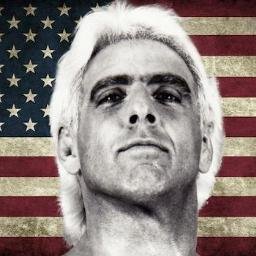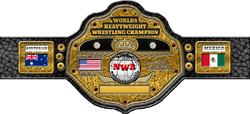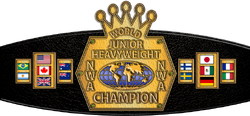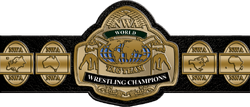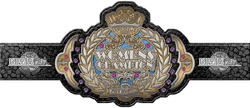Post by WR91 on Sept 1, 2020 19:00:43 GMT 1
iDOM 2020 - National Wrestling Alliance (Full Backstory)

The National Wrestling Alliance (NWA) is the largest governing body for a group of independent professional wrestling promotions and sanctions various NWA championships, including four championships of "World Title" stature. The NWA has been in operation since 1948, and is the sole governing body for most of professional wrestling. It operates as a talent and brand name franchiser for the inter-regional "territory" system.
--Classic Territory System Era--
(1940s)
Before the NWA was founded in 1948, there existed many regional promotions across North America and Japan (each promoting its own "World" champion). However, none of them had backing or recognition outside of their own respective geographic base-areas. The concept of the NWA was to consolidate the championships of these disparate regional companies into one true world championship of pro wrestling, whose holder would be recognized worldwide.
In 1948, Paul "Pinkie" George, a promoter from the Midwest, founded the original version of the National Wrestling Alliance with the backing of five other promoters (Al Haft, Tony Stecher, Harry Light, Orville Brown, and Sam Muchnick). This newly-formed NWA Board of Directors recognized Orville Brown as the first-ever NWA World champion. During the reign of the second NWA World Heavyweight Champion, Lou Thesz (1949-1956), the title was further unified with several more previously-competing "World" titles, such as those recognized jointly by the National Wrestling Association and American Wrestling Alliance (in Boston), plus another version promoted from the Los Angeles Olympic Auditorium. This legitimized the NWA's claim that its title (The NWA World Heavyweight Championship) was a "Unified World Title," and its lineage continues to this very day.
The NWA members divided up North America, as well as Japan, into territories that each promoter would "own" and operate in. Having a territory meant that no other NWA member could promote wrestling in that area. If non-NWA promoters tried to promote their show in an NWA territory, then the other member groups were obliged to send stars to help force the intruder out. Reportedly, threats of violence or physical retaliation were used against any promoters (and/or talent) who disregarded the territory system. If any member territory broke the NWA's rules, it faced expulsion, and thus risked missing out on having nationally-known wrestlers appear on their local shows. For most promoters under the NWA umbrella, the benefits of membership were well worth the dues. Usually, the NWA President's territory was the main territory of the entire alliance.
Beyond the benefit of having other promotions to draw on in case of an intruder, each territory also received periodic guest visits from the NWA World Heavyweight Champion. The champion did not have a "home territory" as such, but instead traveled from territory to territory, defending the title against the top stars of each territory. Many promoters would build up to the appearance of "The NWA World Heavyweight Champion" weeks or months in advance, making the local World title matches that much more special, and the shows they headlined more lucrative. In addition, each NWA member promotion usually produced a TV show that aired in their territory only, meaning that the local fans only saw the World champion when he came to their area, not year-round. It was not just the champion that would travel the territories; often, wrestlers from a different area would come into a territory (often the heels / "bad guys"), and run an angle or two with its top local faces ("good guys"). Also, if the local fans ever tired of a wrestler, he could go to a whole new area and perform the same act for new audiences, who would think the act was brand-new.
(1950s)
Upon becoming the booker for Lou Thesz in 1950, Muchnick, who was the head of the St. Louis Wrestling Club, became the new NWA President, and maintained that position until 1960.
In the mid-1950s, serious disputes broke out within the NWA. There were antitrust problems with the government and there were a number of competing factions who wanted to replace Thesz as champion with different wrestlers such as Verne Gagne. There were also disputes over the number of dates wrestled by the champion in various parts of the country.
The first break within the organization occurred in 1957 when Montreal promoter Eddie Quinn walked out of the August NWA meeting in St. Louis. Quinn had fallen out with Sam Muchnick over a number of issues. Quinn was a partner in the St. Louis territory and disagreed with how it was being run. Quinn was also angry that Muchnick had business dealings with rogue promoter (and Quinn rival) Jack Pfefer. At the time Quinn walked out, a wrestler of his named Edouard Carpentier was involved in an angle where he and Lou Thesz were both being presented around the NWA as champion. The original idea was to build the idea of the "disputed" NWA title into a high profile rematch. When Quinn left the NWA, Muchnick announced that Carpentier had never been an official champion and had no claim on the title.
Afterward, Quinn saw the financial possibilities in the Carpentier situation and began to negotiate with factions within the NWA. He offered to have Carpentier lose a title match to their prospective champion thus giving them if they decided to break away a legitimate claim on the world title. In 1958, it was arranged that Carpentier would drop his title to Verne Gagne in Omaha. But at the same time, Quinn also arranged for Capentier to drop his title in Boston to Killer Kowalski which formed the basis for the AAC/Big Time Wrestling (Boston) title which lasted until 1975. Gagne tried for two more years to work things out with the NWA but finally in 1960 left the organization forming the American Wrestling Association. Gagne's win over Carpentier was used to legitimize the world championship status of the AWA title.
In 1959, Quinn began negotiating with the Los Angeles NWA affiliate. The promotion recognized Carpentier as NWA champion in 1959. In June 1961, Carpentier dropped the title for a third time to Fred Blassie. The promotion then left the NWA officially and became the WWA until it returned to the NWA in 1968.
Muchnick's replacement at the NWA's helm in 1960 was Toronto's Frank Tunney; he in turn was succeeded by Fred Kohler, who was the main booker for the new NWA World champion, "Nature Boy" Buddy Rogers.
(1960s)
October 1962 saw Rogers defeated Killer Kowalski, a match which was promoted by Doc Karl Sarpolis, the NWA member promoter in Amarillo, Texas. As a result, Sarpolis rose to the NWA presidency. Rogers became the most popular wrestler of his time, and dominated wrestling shows in the north-eastern U.S. However, the NWA board voted to put the title back on Thesz, a decision which Rogers and the north-eastern promoters backing him were loath to accept. Nevertheless, the board's decision prevailed, and Thesz defeated Rogers in Toronto on January 24, 1963. In reaction to the move, the north-eastern member promotion, Capitol Wrestling Corporation, seceded from the NWA and renamed itself the World Wide Wrestling Federation (WWWF), later to be known as the World Wrestling Federation (WWF). The WWWF, headed by Vince McMahon, Sr. and Toots Mondt, recognized Rogers as its first World champion in April 1963. Although both Verne Gagne and Vince McMahon promoted their own World champions, their promotions continued to have representatives on the NWA Board of Directors and regularly exchanged talent with NWA promotions.
(1970s)
The 1970's saw the National Wrestling Alliance on a truly Global scale when NWA Champion Jack Brisco dropped the title to Giant Baba in Kagoshima Japan. Briscoe would regain the title six days later in Toyohashi, but Baba had already cemented his name in the record books as the first Japanese wrestler to win the title. While the first half of the '70's were dominated by the Funk Brothers and Jack Briscoe, the second half undoubtedly belonged to two of the NWA's (now) most legendary names in Harley Race and "The American Dream" Dusty Rhodes.
Second only to André the Giant in terms of world wide fame and fan support, Dusty was probably the most loved wrestler in the sport from the mid-1970's throughout the 1980's, consistently drawing exceptionally large crowds wherever he wrestled. There was something different about the fast talking, down-to-earth "son of a plumber" that endeared him to wrestling fans everywhere, and his non-stop travelling between promotions helped him become one of the top 5 drawing cards in the history of wrestling. Race had already made a name for himself in 1973 when he upset Dory Funk, Jr. for the NWA title, and was revered for his ring skill, legitimate toughness, and ability to put on classic matches. The two would trade the title an astonishing 4 times throughout their careers.
--Decline of the Classic Territory System--
(Early 1980s)
In the 1980s, video tape trading and cable television paved the way for the eventual death of the NWA's classic inter-regional business model, as fans could now see for themselves the plot holes and inconsistencies between the different regional storylines. Also, the presence of stars like Dusty Rhodes, and Harley Race on TV every week made their special appearances in each region less of a draw. Vince McMahon, Jr., who had bought the WWWF from his father and renamed it the World Wrestling Federation (WWF) in 1982, used these gathering trends, as well as raids of competing promoters' talent pools, to turn his north-eastern territory into the first truly national promotion. To compete against this threat, various NWA promoters, along with the AWA, attempted to co-promote shows under the Pro Wrestling USA banner. However, internal disputes over power and money caused this deal to eventually fall apart. The AWA ended up owning the group's ESPN timeslot, and used it to broadcast its own weekly shows.
Meanwhile, to hold off the threat of the WWF, Charlotte, North Carolina-based Jim Crockett Promotions decided to unify certain NWA territories and "go national" itself. Accordingly, Jim Crockett, Jr. began buying out some of the other NWA member promotions including Mid South or, in some cases, allowed them to quietly die and just absorbed their rosters. Because of his acquisition spree, and because he failed in proper marketing, TV production values, and merchandising, Crockett was quickly swimming in debt. As a result, in 1984 he sold the company to Ric Flair. Flair had been a rising star in the NWA before a tragic plane crash ended his career. Flair had also been one of Crockett's right hand men, and had an amazing mind for the business.
RFP wasn't the only NWA promotion expanding its borders as World Class Championship Wrestling consumed various promotions in the South West. In Mexico, EMLL with the backing of the NWA also consumed or put out of business most promotions south of the border and in 1987 the promotion changed its name to Imperio De Lucha Azteca (ILA). With Cable TV exposing the plot holes in the classic territorial system however, it was clear that a new order would certainly need to devised.
--Death of the WWF & Revision of the Territory System--
It was of course, Vince McMahon, Jr. that shattered the traditional territorial system, and exposed the plot holes of it. NWA promoters were furious when McMahon began syndicating WWF television shows to television stations across the United States, in areas outside of the WWF's traditional north-eastern stronghold. McMahon also began selling videotapes of WWF events outside the Northeast through his Coliseum Video distribution company. He effectively broke the unwritten law of regionalism around which the entire industry had been based. To make matters worse, McMahon used the income generated by advertising, television deals, and tape sales to poach talent from rival promoters.
According to several reports, the elder McMahon warned his son, "Vinny, what are you doing? You'll wind up at the bottom of a river." In spite of such warnings, the younger McMahon had an even bolder ambition: the WWF would tour nationally. However, such a venture required huge capital investment; one that placed the WWF on the verge of financial collapse. The future of not just McMahon's experiment, but also the WWF, the NWA, and the whole industry came down to the success or failure of McMahon's groundbreaking concept, WrestleMania. WrestleMania was a pay-per-view extravaganza (in some areas; most areas of the country saw WrestleMania available on closed-circuit television) that McMahon marketed as being the Super Bowl of professional wrestling.
The concept of a wrestling super card was nothing new in North America; the NWA had been running Starrcade a few years prior to WrestleMania, and even the elder McMahon had marketed large Shea Stadium cards viewable in closed-circuit locations. However, McMahon wanted to take the WWF to the mainstream, targeting the public who were not regular wrestling fans. He spent loads of money on celebrities such as Mr. T and Cyndi Lauper to participate in the event.
WrestleMania, held in 1985, was a resounding failure. As Gregory Thatus put it in his book, "The Fall of the World Wrestling Federation,"
"WrestleMania was a colossal failure, and crippled the World Wrestling Federation in such a way that it was termed 'Black Sunday' within the promotion, and led to the eventual bankruptcy of Vincent Kennedy McMahon Jr. within months, paving the way for the National Wrestling Alliance's domination."
Sports Entertainment was dead at birth. Within months the WWF ceased operations, and in its wake the NWA launched a new campaign to revamp their Territorial System. Cable Television had changed the business in a way that it could not go back to the way things once were, each promotion while separate had to add to the NWA as a whole. In 1985 Ted DiBiase defeated Dusty Rhodes for the NWA World Heavyweight Championship, and in turn the NWA gave control of the NWA Championship to Ric Flair Promotions.
(Late 1980s)
With control of the NWA World Championship in RFP, and the plot lines of the old territorial system exposed, the NWA World Champion began to tour less (In an effort to make instances when he did seem more meaningful.) As well, many territories including RFP, WCCW and ILA began airing Cable Television shows of their own and the NWA made an effort to update fans on going ons all around the Alliance with "NWA News" segments that appeared on all territories' broadcasts, and established an "NWA Hotline" that fans could call for "breaking news" at a fee per minute basis. The NWA also sanctioned various NWA wide super cards including the biggest event of the year, Starrcade.
It's also important to note that in 1986, Dusty Rhodes purchased World Class Championship Wrestling, and established a lucrative co promoting deal with Ric Flair Promotions that delivered a large number of lucrative shows.
The breakout success story of the period however was that of a young, charismatic and flamboyant newcomer by the name of Sting. With his bleached blond hair and varying colorful face painted designs, not to mention his great athletic ability, Sting had become massively over all across the NWA, especially in the Mid Atlantic and all across the south. On November 26, 1987 Sting defeated Ted DiBiase for the NWA World Heavyweight Championship a mere two years after his pro debut. With the working relationship between RCP and WCCW in full effect, Sting finished out the 80's as the new face of the NWA and traded the title back and fourth with Michael Hayes in perhaps the greatest feud of the decade.
(1990s)
The '90's began in a bit of controversy in what is often known as the "Controversy Over Canada." In 1990, Sting was out with an injury but wanted to put the title on Bret Hart, who had built a reputation for himself as "the best wrestler in anywhere in the World." The NWA wanted Michael Hayes, who was the reigning Champion to drop the title to Bret in Calgary. Hayes, for whatever reason claimed that in his contract as Champion, he was in no way contractually obligated to go to Canada, or tour anywhere for that matter to drop the title. The NWA answered back by stripping Hayes of the championship, but there was only one problem. Hayes had the physical possession of the title belt. When the NWA offered to give back the deposit Hayes had put down on the title, he rejected it and kept the strap. With no other option, and a tournament for the belt scheduled in Calgary, the NWA came up with a new belt design, one that is often today nicknamed "Big Gold," or the "Big Gold Belt."
Undeterred, the scheduled tournament for the Championship went as planned with Bret Hart going over Davey Boy Smith in the finals. While Bret stayed primarily in Canada, he did make sporadic appearances in Memphis Championship Wrestling and Ric Flair Promotions. "The Hitman" Held onto the strap before dropping it to Davey Boy Smith in London, England on Dec. 28, 1992. It was during Davey Boy's reign as Champion that yet another controversy would arise.
In 1993 the wrestling world was abuzz with the news that Vince McMahon of all people was back in the wrestling business, and of all places, in the NWA. In the "Handshake That Shocked the World," NWA President Harley Race shook McMahon's hand and accepted the payment into the National Wrestling Alliance of McMahon's new promotion, Titan Wrestling Entertainment. McMahon, ever the salesman had now joined up with his enemies.
However the larger story broke out in that McMahon had signed Davey Boy Smith, the reigning NWA Champion to an exclusive contract, and that his contractual obligations would prevent him from defending the title in Canada as scheduled against Bret Hart. The NWA, not wanting their World Title in McMahon's promotion then scheduled an earlier show down between Hart and Smith in Memphis, where Bret regained the title.
The 90's also saw the emergence of new promotions into the NWA as Eastern Championship Wrestling debuted, and went gradually from a family oriented style to a style that would become known as "Hardcore" and based off of Japanese Death Matches. The NWA wasn't at all impressed, and put constant pressure on the group. As well, Sabu, the nephew of the legendary "Original Sheik" revive his Uncle's territory in Detroit and name it Motor City Wrestling.
In 1996, Sting regained the World Heavyweight Championship after a successful tag team run with Lex Luger that saw the duo win the NWA World Tag Team Championship a number of times. Sting would become a travelling Champion as he visited a number of North American territories, the United Kingdom, and Japan. As the decade closed, Sting dropped the title to Mark Callous at a WCCW show and the title would remain there for the next two years, being traded by Dusty Rhodes and his son Dustin Rhodes in a feud that got very bloody at times.
(2000s)
In 2000 no one man was hotter than "Superstar" Steve Austin. A former member of the Hollywood Blonds, and former World Tag Team Champion, Austin had landed a few roles in Hollywood movies and television series that saw him change his character from a brash redneck, to an overconfident wannabe movie star. His act and star power became so popular that by December he topped The Giant, Paul Wight to become the NWA World Champion. Austin's reign lasted nearly a year before tragedy struck in October of 2001 when he was involved in a head on collision while travelling home. With the title picture in shambles, and the hottest star in wrestling out for what some thought for the rest of his career, it was decided that the title would be put on one of the breakout young stars in WCCW, a former Olympic Gold Medallist in Kurt Angle.
Angle had began his professional career in Ric Flair Promotions, where he quickly won the NWA United States Championship. Angle's thirst for Gold wouldn't be quenched by any secondary title though, and he moved to WCCW where he mixed it up in the Main Event scene. Quickly advancing through a one night tournament, Angle pinned Jeff Jarrett at Starrcade to win his first World Title.
In Kurt Angle, the NWA saw an investment. As an Olympic Gold Medalist, Angle brought a sense of legitimacy like never before. It's no wonder then that the NWA spent the time on Angle with a lengthy reign on top of the ladder over the next five years, with brief interruptions by Paul Wight, Chris Benoit (who became the NWA's first Triple Crown Champion in doing so) and Sting. Angle was also a controversial Champion, and such an effective heel champion that he could get the crowds to reach riotous amounts of anger. One instance in particular occurred on February 17, 2002 at NWA Motor City's Original Sheik Memorial Show. Angle, the reigning NWA Champion defended his title against Sabu in a Hardcore Match. Sabu pinned Angle, and in turn thought he had won the title, but Angle quickly got on the microphone and demanded that it was against NWA Rules to defend the title in a Hardcore Match. Therefor, the match was restarted as a traditional affair, and in the end, Angle forced Sabu to tap out to the Ankle lock in the center of the ring. Angle narrowly escaped as the crowd broke through the barricade hot after him.
As 2007 came around, there was no more clear of a number one contender for Angle's strap than Brock Lesnar. After placing third in the 2004 Olympics, Lesnar signed with WCCW at the urging of Angle himself. Brock was pushed hard from the get go, winning quick and decisive matches. Before you knew it, two years had passed and still unbeaten, Lesnar boasted a record of 225 wins, and 0 losses. Billed as the matchup between the two finest wrestlers on the planet, Lesnar defeated Angle on April 15, 2007 for the NWA Title in San Antonio, Texas keeping his undefeated streak in tact and becoming the first man to ever win the Championship with a perfect record.
Concurrent to the rise of a new star in Brock Lesnar, was the resurrection of a former one in "Superstar" Steve Austin. After his horrific car crash that cost him the title in 2000, many thought Austin would never be seen in the ring again. Be it a miracle, or just strong personal will power, Austin returned to the ring in 2006 with his injuries seemingly fully healed. He sought to pick up where he left off and win back the title that he was never rightfully defeated for. The Austin/Lesnar rivalry would become the hottest act of 2008.
In their first encounter in March 2008, at World Class Championship Wrestling's "WrestleWar" pay per view, Austin took Lesnar to the limit - literally like no man had ever done before. Austin, in many eyes even had the Lesnar pinned following his Lights, Camera, Action! finishing maneuver, but the referee was down and unable to make the count. Following miscommunication between the referee and Austin, Lesnar was able to nail "The Superstar" with the F-5 and retain his championship. However, Lesnar knew full well how much of a threat Austin truly presented to his reign atop the NWA.
In order to receive another shot at the NWA World Heavyweight Championship, Austin found himself with the monumental task of winning an NWA-wide inter-promotional sixty man (two ring) Battle Royal at the NWA World War III Pay Per View in October. Had it not been for RFP's Randy Orton, that mission would have been a complete success. In a way it was, as Orton charged at "The Superstar" with a lariat that sent both men tumbling over the top ropes, and out to the arena floor. Surrounded in controversy over the next few weeks as to just who won the match, President JJ Dillon decreed that both Austin and Orton were eliminated at the same time, and therefore both would receive the title shot at Starrcade.
To many fans, Orton's sudden push, and involvement in the Austin/Lesnar feud was frustrating. Not only for the fact that Orton had been a troubled member of the Ric Flair Promotions roster who had a chequered past with drug abuse, but for the fact that many saw Starrcade as the ultimate place for Austin to finally unseat the monstrous Lesnar for the title - without anyone else in the match.
Starrcade 2008 went ahead with the Triple Threat Main Event for the NWA World Heavyweight Championship. Orton spent most of the match moving in and outside of the ring "choosing" the time to get involved when it was to his benefit. Austin and Lesnar on the other hand chose to tear into one another, with their near year long rivalry coming to a head. In the end, the fans got what they paid to see - A Lights, Camera, Action! to both Orton and eventually Lesnar, who Austin pinned (giving him his first pinfall loss in the process) to complete his seven year journey back to the top of the mountain as NWA World Heavyweight Champion.
Though Austin was undoubtedly one of the most popular acts in all of the NWA, his "Cinderella" rise back to the top would come to an end in February of 2009 when he was defeated by Randy Orton at Ric Flair Promotions' SuperBrawl pay per view. The fact that the belt was placed on Orton to begin with, let alone at the expense of Austin angered fans worldwide who saw the third generation wrestler's sudden rise to the top as him being "pushed down their throats." His reign would last a mere five months, with defences over Kevin Vegas (his retirement match), then NWA United States Champion Brent Albright, and Jeff Jarrett before the plug was finally pulled and the strap was put on Chris Jericho on July 7, 2009 at The Great American Bash.
Jericho, who had been "passed the torch" by Sting in his retirement match at Starrcade 2008 was seen as more than a ready candidate for the title for years, and finally things had aligned to where he was placed as the face of the NWA. Heading into the beginning of 2010 there are a plethora of challengers to Jericho's strap including Brock Lesnar, Sexton Hardcastle, and more. However his most sudden challenge appears to be Kurt Angle who has already pinned the NWA Champion (non title) in the last match of 2009.
(2010s)
Over the course of the next few years, Jericho continued to dominate the world of professional wrestling retaining the Worlds Heavyweight title until 2013 when the emergence of Bryan Danielson from MCW sparked a flame in the wrestling world. Danielson and Jericho battled to four one hour time limit draws through most of the year. In their fifth contest between the two, at July 4th's The Great American Bash 2013, Jericho tapped out to the Danielson Lock thus ending Jericho's 1,458 day title reign. Danielson continued to retain and defend the title for just over a year and a half when Brent Albright defeated Danielson for the championship in March of 2015. Albright's title reign didn't last all that long at just four months with Danielson picking up the championship once more. In January 2015, Titan Wrestling Entertainment lost their exclusive rights to the NWA World Women's championship after their ten year deal to retain the rights had expired. Thus the NWA World Women's championship being able to once again be defended across all of the NWA.
Over the course of the next few years the likes of Christopher Daniels, Matt Cappotelli, Adam Pearce, Nigel McGuinness, Bryan Danielson and Randy Orton all have traded off and held the ten pounds of gold. Now it is in the hands of Cody Rhodes. What will come of his reign? Only time will tell.
**Note**
(Original concept by creator iDOL with help from TheWho87 and LJC based off of TEW 2005 game)




